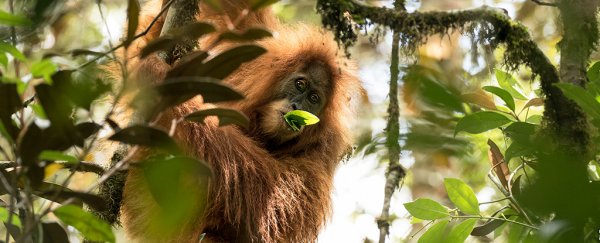The small family of great ape species just got a new member - a previously unclassified type of orangutan living in an isolated colony in Sumatra.
Unfortunately, the population of these newfound orangutans is so small, they've immediately joined the list of some of the most endangered primates in the world.
An international team of researchers has named the newly identified species the Tapanuli orangutan (Pongo tapanuliensis), based on the Tapanuli district in northern Sumatra where it lives.
The team argues that the orangutans they've found in the small forest of Batang Toru are "a geographically and genetically isolated population" living further south from the existing range of Sumatran orangutans.
"It isn't an everyday event that we find a new species of great ape, so indeed the discovery is very exciting," says senior researcher, evolutionary anthropologist Michael Krutzen from the University of Zurich in Switzerland.
A rumoured population of what are now Tapanuli orangutans was first confirmed to exist in 1997, and primate researchers immediately set to work to figure out whether these orangutans were the same as ones living elsewhere on Sumatra.
Early research indicated both behavioural and genetic differences, but it wasn't enough to warrant the designation of a new species - since the world only has six great ape species overall, that would be a pretty big deal.
Then, in 2013 the scientists lucked out with a complete skeleton of an adult male orangutan which had died in a fight with some local villagers. This became the holotype - a single specimen which forms the basis for the description of a new species.
Through comparisons of the holotype with other existing orangutan samples held at ten institutions around the world, the researchers identified significant differences in the jaw and teeth of the new species.
The discovery brings the count of orangutan species to three, as the Tapanuli orangutan joins the ranks of Sumatran and Bornean orangutans, which were only distinguished from each other in 1996.
Additionally, in-depth genetic analysis has revealed that Tapanuli orangutans are actually the oldest orangutan species of the three - their branch split off the original orangutan species more than three million years ago.
Meanwhile Bornean and Sumatran orangutans separated only 700,000 years ago.
"The Batang Toru orangutans appear to be direct descendants of the initial orangutans that had migrated from mainland Asia, and thus constitute the oldest evolutionary line within the genus Pongo," says one of the team, evolutionary biologist Alexander Nater from the University of Zurich.
Sadly, only 800 Tapanuli orangutans are known to exist, making them the least numerous of all great apes and possibly warranting a classification of being critically endangered.
The team notes that we will need to quickly implement conservation measures to ensure that illegal logging, road construction, and other human threats don't impact the long-term survival of the species.
What makes this discovery even more exciting - and important - is the implication that there's still so much we don't know about the biodiversity of our planet.
"Great apes are among the best-studied species in the world," says one of the team, Erik Meijaard from the Australian National University.
"If after 200 years of serious biological research we can still find new species in this group, what does it tell us about all the other stuff that we are overlooking: hidden species, unknown ecological relationships, critical thresholds we shouldn't cross?"
The study was published in Current Biology.
